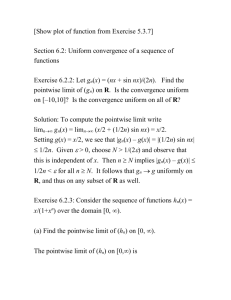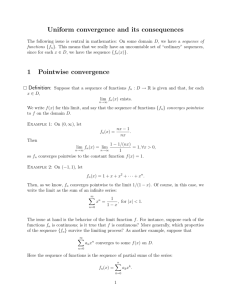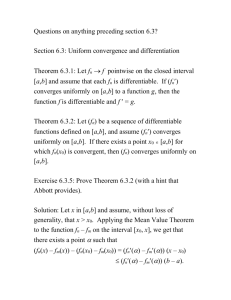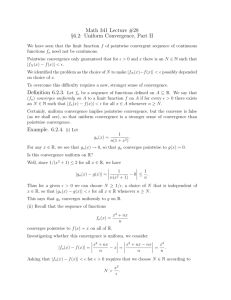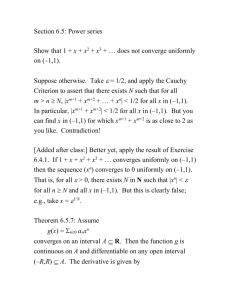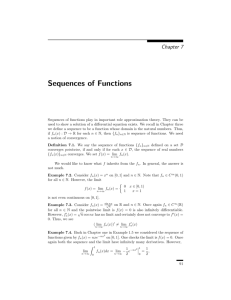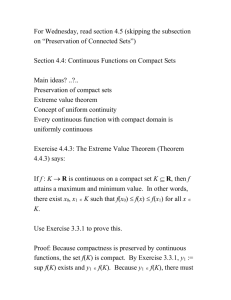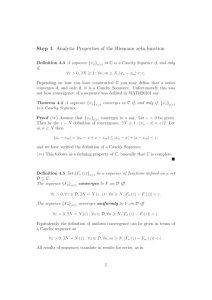Real Analysis II Chapter 9 Sequences and Series of Functions 9.1
advertisement
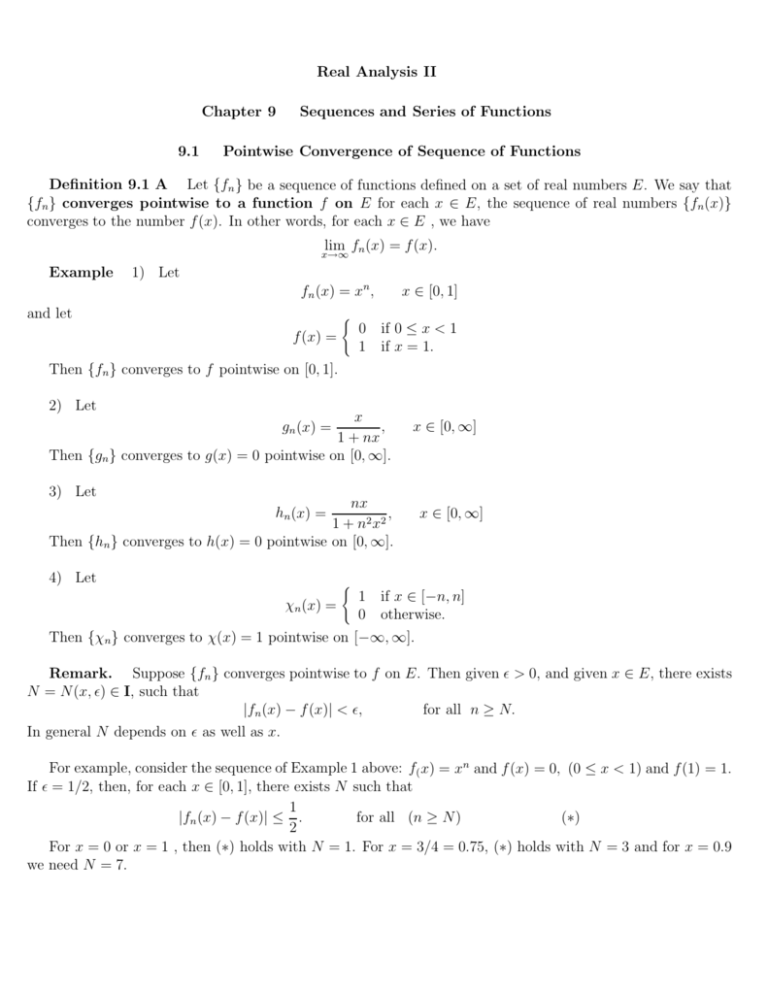
Real Analysis II
Chapter 9
9.1
Sequences and Series of Functions
Pointwise Convergence of Sequence of Functions
Definition 9.1 A Let {fn } be a sequence of functions defined on a set of real numbers E. We say that
{fn } converges pointwise to a function f on E for each x ∈ E, the sequence of real numbers {fn (x)}
converges to the number f (x). In other words, for each x ∈ E , we have
lim fn (x) = f (x).
x→∞
Example
1) Let
fn (x) = xn ,
and let
f (x) =
(
0
1
x ∈ [0, 1]
if 0 ≤ x < 1
if x = 1.
Then {fn } converges to f pointwise on [0, 1].
2) Let
x
,
1 + nx
Then {gn } converges to g(x) = 0 pointwise on [0, ∞].
gn (x) =
x ∈ [0, ∞]
3) Let
nx
,
1 + n 2 x2
Then {hn } converges to h(x) = 0 pointwise on [0, ∞].
hn (x) =
4) Let
χn (x) =
(
1
0
x ∈ [0, ∞]
if x ∈ [−n, n]
otherwise.
Then {χn} converges to χ(x) = 1 pointwise on [−∞, ∞].
Remark. Suppose {fn } converges pointwise to f on E. Then given > 0, and given x ∈ E, there exists
N = N (x, ) ∈ I, such that
|fn (x) − f (x)| < ,
for all n ≥ N.
In general N depends on as well as x.
For example, consider the sequence of Example 1 above: f( x) = xn and f (x) = 0, (0 ≤ x < 1) and f (1) = 1.
If = 1/2, then, for each x ∈ [0, 1], there exists N such that
1
|fn (x) − f (x)| ≤ .
for all (n ≥ N )
(∗)
2
For x = 0 or x = 1 , then (∗) holds with N = 1. For x = 3/4 = 0.75, (∗) holds with N = 3 and for x = 0.9
we need N = 7.
We claim that there is no N for which (∗) hold for all x ∈ [0, 1]. For if there is such an N , then for all
x ∈ [0, 1), (*) implies
1
xn < .
2
In particular we would have
1
xN <
2
−
for all x ∈ [0, 1). Taking limit as x → 1 we would have 1 ≤ 1/2, which is a contradiction.
If gn is as given in Example 2 above :
gn (x) =
x
,
1 + nx
then we have
1
n
for all x ∈ [0, ∞) and hence for a given > 0 , any N with N > 1/ will imply that
gn (x) ≤
|gn (x) − 0| < for all n > N and for all x ∈ [0, ∞).
We leave to you to analyze the situations for the sequences in Examples 3 and 4 above.
9.2
Uniform Convergence of Sequence of Functions
Definition 9.2A Let {fn } be a sequence of functions on E. We say that {fn } converges uniformly to
f on E if for given > 0, there exists N = N (), depending on only, such that
|fn (x) − f (x)| < for all n > N and for all x ∈ E.
If {fn } converges to f uniformly to f on E, we write
fn → f uniformly on E.
Remark. 1)
Unlike the pointwise converges, in the case of uniform convergence, we note N depends
only on and not on x.
2) If fn → f uniformly on E, then fn → f pointwise on E. The sequence fn (x) = xn on [0, 1] discussed in
Example 1 of the previous section shows that the converse of the above statement is not true.
Example The sequence
x
1 + nx
converges uniformly to 0 on [0, ∞). It is a good exercise to show whether the sequences of Examples 3 and 4
of the previous section are uniformly convergent or not.
gn (x) =
The following corollary is a restatement of the definition of uniform converges. It is useful to show that a
sequence is not uniformly convergent.
Corollary 9.2B The sequence {fn } does not converge uniformly to f on E if and only if there exists an
> 0 such that there is no N > 0 for which
|fn (x) − f (x)|, holds.
for all n > N for all x ∈ E
Remark 1) If fn → f uniformly on E and > 0, then there exists N > 0 such that for all n > N , the
entire graph of y = fn (x) lies between the graphs of y = f (x) − and y = f (x) + .
2) If fn → 0 uniformly on E and > 0, then there exists N > 0 such that for all n > N and all x ∈ E,
|fn (x)| < . This implies that for all n > N ,
sup |fn (x)| ≤ and hence
lim sup |fn (x)| ≤ .
n→∞ x∈E
x∈E
Since > 0 is an arbitrary positive number, we conclude that
If fn → 0 uniformly on E, then
lim sup |fn (x)| = 0.
n→∞ x∈E
The converse is also true and the proof is an exercise.
Example For the sequence
hn (x) =
we have
sup |hn (x)| ≥ hn
x∈[0,∞)
1
1
=
n
2
nx
1 + n 2 x2
and hence
lim sup |hn (x)| 6= 0.
n→∞ x∈[0,∞)
Thus {hn } does not converge uniformly to 0 on [0, ∞).
Theorem 9.2E
fn → f
uniformly on E if and only if lim sup |fn (x) − f (x)| = 0.
n→∞ x∈E
Theorem 9.2F (Cauchy Criterion for Uniform Convergence) A sequence {fn } converges uniformly
on E if and only if for a given > 0, there exists N > 0 such that for all n ≥ m > N and for all x ∈ E,
|fn (x) − fm (x)| < .
Theorem 9.2G If {fn } is a sequence of continuous functions on a bounded and closed interval [a, b] and
{fn } converges pointwise to a continuous function f on [a, b], then fn → f uniformly on [a, b].
9.3
Consequences of Uniform Convergence
Theorem 9.3A If fn → f uniformly on [a, b], if fn are continuous at c ∈ [a, b], then f is continuous at c.
Corollary 9.3B If fn → f uniformly on [a, b], if fn are continuous on [a, b], then f is continuous on [a, b].
Remark Does fn ∈ R[a, b] and f → f pointwise on [a, b] imply that f ∈ R[a, b]? The answer is no. For
example, let
A = {r1 , r2 , r3, · · ·}
be the set of all rational numbers in [0, 1], and let
An = {r1 , r2 , · · · , rn }.
Let χn be the characteristic function of An and χ be the characteristic of A. Since χn is discontinuous only at
a finite number of points (where ?), we see that χn ∈ R[a, b]. On the other hand, χ is not continuouos at any
point in [0, 1] and hence χ 6∈ R[a, b]. Clearly χn → χ on [0, 1] pointwise.
Theorem 9.3E If fn ∈ R[a, b] and if fn → f uniformly on [a, b], then f ∈ R[a, b].
nx
Remark In Theorems 9.3A and 9.3E, uniform convergence is sufficient. The sequence hn (x) = 1+n
2 x2
for x ∈ [0, ∞), converges to the continuous function h(x) = 0. Recall that the converges is not uniform. The
sequence fn (x) = xn on [0, 1] can be used to show that uniform convergence is not necessary for theorem 9.3E
(explain).
Remark When does fn → f imply
example. Let
Rb
a
f →
Rb
2n
if
0
otherwise
fn (x) =
Then
Z
1
Z
2
n
a
f ? To answer this question, we consider the following
1
n
≤x≤
2
n
Z
1
1
2
−
=
2
and
hence
lim
fn (x) dx = 2.
1
n→∞ 0
n n
0
n
On the other hand, for fixed x ∈ [0, 1], we can choose an N so that x > 2/N and hence fn (x) = 0 for all n ≥ N .
Therefore
Z 1
fn → 0 pointwise and hence
lim fn (x) dx = 0.
fn (x) dx =
2n dx = 2n
0 n→∞
Theorem 9.3G If fn ∈ R[a, b] and if fn → f uniformly on [a, b], then
Z
b
f →
a
Remark Let fn (x) =
Thus
xn
n
Z
b
f.
a
on [0, 1] and let f (x) = 0. Then fn → f uniformly but fn0 (1) = 1 while f 0 (1) = 0.
lim f 0 (x)
n→∞ n
= f 0 (x)
does not hold at x = 1.
Theorem 9.3I If fn0 (x) exists for each n and each x ∈ [a, b], if fn0 is continuous on [a, b], if {fn } convegres
uniformly to f on [a, b], and if {fn0 } convegres uniformly to g on [a, b], then g = f 0 .
9.4
Convergence and Uniform Convergence of Series of Functions
P
Definiton 9.4A Let {un } be a sequence of functions and let sn (x) = nk=1 uk (x) be the nth partial sum
P
P∞
of the infintie series ∞
k=1 uk (x). We say
k=1 uk converges pointwise to f on E if sn → f pointwise on E. In
this case we write
∞
X
uk = f pointwise on E
k=1
x
. Then
Example Let uk = xk , −1 < x < 1 and let f (x) 1−x
∞
X
Definiton 9.4B We say that
uk = f pointwise on (−1, 1).
k=1
P∞
k=1 uk converges to f uniformly on E
∞
X
uk = f
k=1
uniformly on E
if sn → f uniformly on E. We write
Theorem 9.4C If
P∞
k=1
uk = f uniformly on E, and if {uk } is continuous on E, then f is continuous on E.
Exnaple Let
n
un (x) = x(1 − x ), (0 ≤ x ≤ 1, n = 0, 1, 2, · · ·), and let f (x) =
(
1, if 0 < x ≤ 1
0, if x = 0.
P
Then un = f pointwise on [0, 1].(Verify this) Clearly f is not continuous at x = 0 while un is continuous
for each n.
Theorem 9.4E (Weierstrass M-Test) If {uk } is a sequence of continuous functions such that |uk (x)| ≤
P
Mk for all x ∈ E and if Mk is convergent, then
∞
X
uk = f
uniformly on E
k=1
Notation if {ak } and {bk } are two sequences, and if ak ≤ bk , we write
∞
X
ak <<
k=1
∞
X
bk
k=1
Thus Weierstrass’ Theorem states that
if
∞
X
uk <<
k=1
∞
X
Mk < ∞, then, for some functionf,
k=1
Example Since
∞
X
uk = f uniformly on E
k=1
∞
X
∞
X
sin(nx)
1
<<
< ∞,
2
2
n
n=1
n=1 n
Weierstrass’Theorem implies that
∞
X
sin(nx)
n2
n=1
converges uniformly on R.
P
k
Theorem 9.4F If the power series ∞
k=0 ak x converges for x = x0 (with x0 6= 0), then the power series
converges uniformly on [−x1, x1] for any x1 ∈ [0, |x0|].
Theorem 9.4G Let {uk } is a sequence of continouous nonnegative functions on [a, b] and if
convgres pointwise to a continuous function f on [a, b], then
∞
X
k=1
uk = f uniformly on [a, b].
P∞
k=0
uk
9.5
Integration and Differentiation of Series of Functions
Theorem 9.5A Let {uk } be sequence of fucntions in R[a, b]. and suppose
[a, b]. Then f ∈ R[a, b] and
Z
b
f (x) dx =
Z
a
∞
X
b
a
!
uk (x) dx =
k=1
∞
X
k=1
Z
k=1
uk (x) dx
Theorem 9.5B If {uk } is differentiable on [a, b], if {u0k } is continuous on [a, b], if
P
and if u0k converges uniformly on [a, b], then
∞
X
uk = f uniformly on
!
b
a
P∞
P
uk = f uniformly,
u0k (x) = f 0 (x)
k=1
Example 1)
1 − x + x2 − x3 + · · · =
1
1+x
uniformly on (0, 1)
implies that for any y ∈ (0, 1),
Z
y
1dx −
0
Z
y
xdx +
0
Z
y
2
x dx −
0
from which we conclude that
y−
Z
y
3
x dx + · · · =
Z
0
y
0
1
dx
1+x
y2 y3 y4
+
−
+ · · · = log(1 + y).
2
3
4
2)
1
1−x
1 + x + x2 + x3 + · · · =
uniformly on (0, 1)
implies that for all x ∈ (−1, 1),
1 + 2x + 3x2 + 4x3 + · · · =
Theorem 9.5C
x ∈ [−b, b],
If the power series
P∞
k=0
1
.
(1 − x)2
ak xk convegres to f (x) on [−b, b] for some b > 0, then for any
f 0 (x) =
∞
X
kak xk−1 .
k=1
Corollary 9.5D
If f (x) =
∞
X
k=0
ak xk ,
then
f (n) (x) =
∞
X
k(k − 1)(k − 2) · · · (k − n + 1)ak xk−n .
k=n
Example (A Continuous Nowhere Differentiable Function)
Let f0(x) = the distance from x to the nearest integer. (Thus f0(0.45) = 0.45 and f0(3.67) = 0.33)
Define fk (x) = fk (10k x) and
∞
X
fk (x)
F (x) =
.
10k
k=0
Then F is continouos everywhere and differentiable nowhere.
Example
Another example of everywhere continuous and nowhere differentiable function is due to
Weierstrass and is given by
∞
X
cos (3n x)
.
G(x) =
2n
k=0
